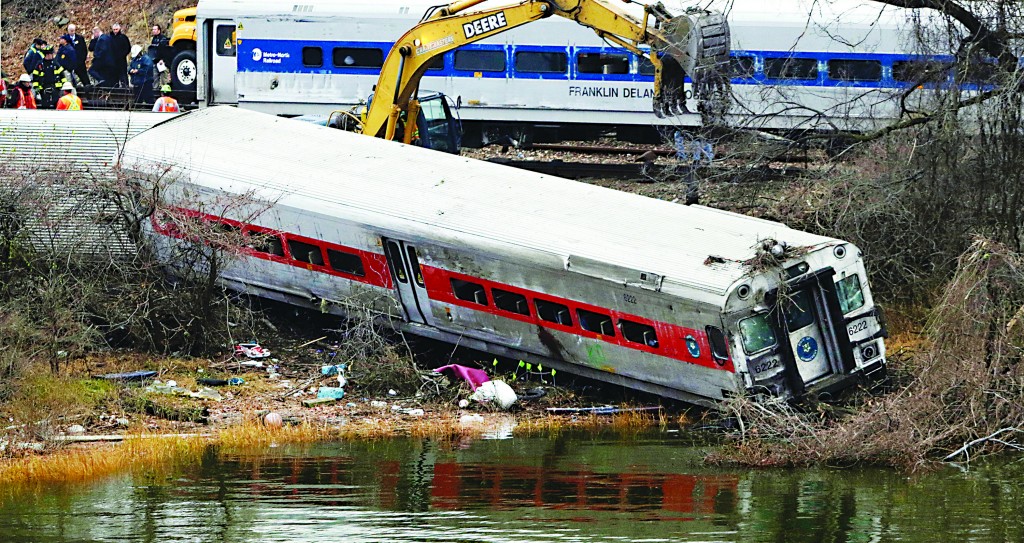Train Sped Near Triple Limit Before Wreck

The train that derailed in the Bronx killing four and injuring dozens was traveling 82 mph as it approached a 30 mph zone, nearly triple the allowable sped limit, the National Transportation Safety Board said Monday.
The Metro-North Railroad commuter train jumped the tracks Sunday morning along a curve so sharp that the speed limit drops from 70 mph to 30 mph. As workers righted the fallen cars, federal investigators downloaded data from the train’s rear-mounted locomotive, and a data recorder from the front car was sent to Washington for analysis, NTSB board member Earl Weener said. The devices could shed light on such things as the train’s speed and the use of its brakes.
“We’ve had some success already” in extracting data, but the information has to be validated before it is made public, Weener said.
The wreck in the Bronx came two years before the federal government’s deadline for Metro-North and other railroads to install automatic-slowdown technology designed to prevent catastrophic accidents. But with the cause of Sunday’s wreck unknown, it was not clear whether the technology would have made a difference.
Investigators planned to interview the engineer and conductor, Weener said. The engineer, William Rockefeller, was injured and “is totally traumatized by everything that has happened,” said Anthony Bottalico, executive director of the rail employees union. He said Rockefeller, 46, was cooperating fully with investigators.
 “He’s a sincere human being with an impeccable record that I know of. He’s diligent and competent,” Bottalico said. Rockefeller has been an engineer for about 11 years and a Metro-North employee for about 20, he said.
“He’s a sincere human being with an impeccable record that I know of. He’s diligent and competent,” Bottalico said. Rockefeller has been an engineer for about 11 years and a Metro-North employee for about 20, he said.
The NTSB has been urging railroads for decades to install technology that can stop wrecks caused by excessive speed or other problems. Congress in 2008 required dozens of railroads, including Metro-North, to install the “positive train control” systems by 2015.
But the systems are expensive and complicated and cannot prevent an accident if there is a brake failure. Railroads are trying to push back the deadline a few years.
The Metropolitan Transportation Authority, which runs Metro-North, awarded $428 million in contracts in September to develop the system for Metro-North and its sister Long Island Rail Road. But the MTA has asked for an extension on the deadline to 2018, saying it faces technological and other hurdles in installing such a system across more than 1,000 rail cars and 1,200 miles of track.
While the train’s seven cars and locomotive were gradually returned to their tracks Monday, the 26,000 weekday riders on the railroad’s affected Hudson Line faced a complicated commute.
Many used shuttle buses and cars to get to work. But no major delays were reported during the early rush hour, railroad spokesman Aaron Donovan said.
Marketing worker Leanne Bloom normally takes the Hudson Line to work but drove to a stop on another line instead. She was surprised to find the train nearly empty.
“I was expecting long lines” at the station, she said. “But I made it very easily.”

On Sunday, the train was about half full, with about 150 people aboard, when it ran off the rails around 7:20 a.m. while rounding a bend where the Harlem and Hudson rivers meet. The lead car landed inches from the water. In addition to the four people killed, more than 60 were injured.
Many victims had been released from hospitals by Monday afternoon.
Seven were still in an intensive-care unit at St. Barnabas Hospital, some with spinal injuries, emergency department director Dr. David Listman said. And two patients were reported in critical condition at New York-Presbyterian Hospital.
The injured included five police officers who were heading to work, according to Mayor Michael Bloomberg, and a 14-year-old boy who was taking a weekend ride with his father on the same train the youngster usually takes to school.
The train’s assistant conductor, Maria Herbert, suffered an eye injury and a broken collarbone, Bottalico said.
Gov. Andrew Cuomo, very reticent when it comes to appearing on national media, spoke to NBC, CNN and Fox News on Monday. He told NBC that he thinks speed will turn out to be a factor in a crash he called “your worst nightmare.”
The MTA identified the dead as Donna L. Smith, 54, of Newburgh; James G. Lovell, 58, of Cold Spring; James M. Ferrari, 59, of Montrose; and Ahn Kisook, 35, of Queens. Three of the dead were found outside the train; one was inside.
The derailment came amid a troubled year for Metro-North, and marked the first time in the railroad’s 31-year history that a passenger was killed in an accident.
This article appeared in print on page 1 of edition of Hamodia.
To Read The Full Story
Are you already a subscriber?
Click "Sign In" to log in!

Become a Web Subscriber
Click “Subscribe” below to begin the process of becoming a new subscriber.

Become a Print + Web Subscriber
Click “Subscribe” below to begin the process of becoming a new subscriber.

Renew Print + Web Subscription
Click “Renew Subscription” below to begin the process of renewing your subscription.








